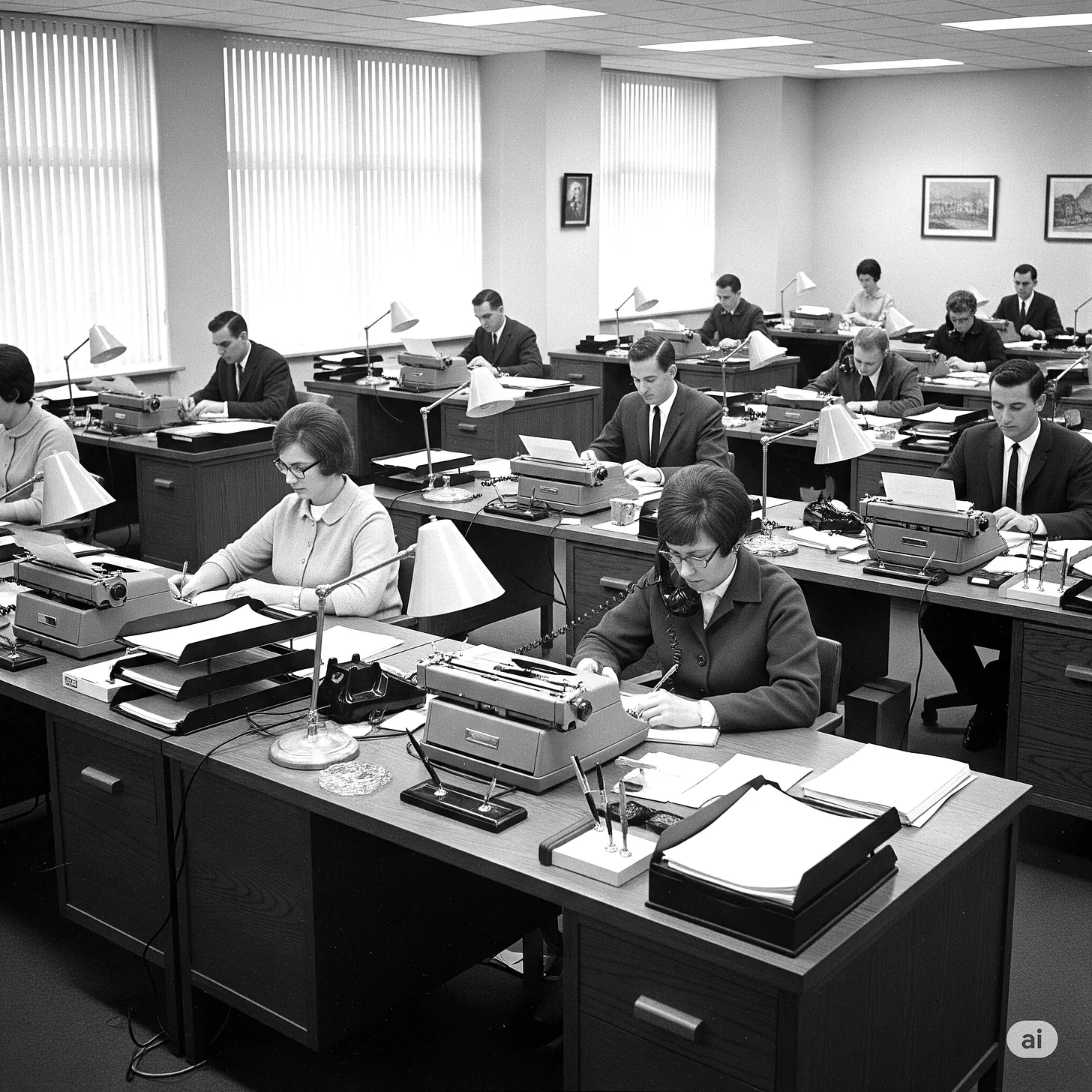The Career Revolution, Part I
I grew up in Northern Minnesota, in mining country. There were some office environments similar to the pic (circa 1965), but mostly, this happened in metro areas like Duluth or, of course, the Twin Cities. Still, the work culture MO fits—ties, typewriters, and uniformity. You worked for one company, rarely switching jobs, and the idea of having a 'side hustle' would have seemed as foreign as carrying a computer in your pocket.
Today, we watch reruns of Mad Men to see what life was like back in the day. Things have changed. Now, the average job lasts 2.8 years, and 36% of the workforce is involved in gig work. And white shirts with narrow dark ties in the office?… come on.
In my upcoming posts, I’ll explore the last 80 years of work in America. I’ve experienced most of it firsthand and observed the differences between these periods. But this isn’t just a walk down memory lane; it’s what I need to do to understand how we got to where we are today, on the verge of major economic change driven by technology, especially AI.
Connecting the dots, era by era helps me, and I hope you, see where we came from and how we reached this point today. I’ll examine:
Organization Era (1945-1979): "When your company was your career"
Quick snapshot: lifetime employment, predictable ladders, institutional identity
Transition Era (1980-1999): "When the rules changed overnight"
Quick snapshot: downsizing, technology disruption, survival mode
Portfolio Era (2000-2025): "When everyone became an entrepreneur"
Quick snapshot: gig economy, personal branding, individual responsibility
Popular culture has become a spectacle of wealth, celebrity, and curated lifestyles that seem increasingly disconnected from the real experiences of most Americans. We’re bombarded with highlight reels—private jets, brand deals, and “quiet luxury”—while most people face very different realities, working hard just to keep things afloat. The cultural narrative cheers for the few who aren’t involved in everyday work, while ignoring the millions who keep everything running. I’m not very interested in the former. That side of the story already gets too much attention. I’m focused on the latter. The true story belongs to the people who show up every day, solve problems, build systems, and carry emotional weight without recognition.
What we call “ordinary” work is anything but. It’s strategic, adaptable, and deeply human. Yet, it’s rarely documented, celebrated, or preserved. The nurse who charts patient care between emergencies, the warehouse manager who motivates a team through chaos, the freelancer stitching together income streams with no safety net—these are the essential players of modern life. Their contributions are foundational, but their visibility is often limited. I’ll discuss this and how to improve it.
I am fascinated by what comes next work-wise here in the USA. It’s on my mind now and most days, and I believe it should be on most people’s minds as well. As AI reshapes industries and automates tasks, the value of human work will shift from execution to insight. The average worker won’t just need new hard skills; they’ll need to see themselves in a new light—as the Free Agent they truly are. Furthermore, to succeed moving forward, workers will need to position themselves to compete in a marketplace with new rules. Adaptability, strategic thinking, and lived experience all matter, but if they aren’t captured and tracked, they vanish into space.
The future will be shaped not by influencers but by those who know how to work, adapt, and lead from the ground up. And they’ll need tools that make their contributions visible and usable—and to this end, a page or two from the Self-Promotional Influencer Manual. We’ll explore this further, too.
In the meantime, for those digital natives out there, imagine a time before smartphones, streaming, social media, flip phones, the internet, personal computers, and even fax machines. How did people manage back then? What was it like to work in those days? We’ll take a look.
One thing, though, is crystal clear: we as people haven’t changed much, but technology has. Since back in the day, housing, transportation, food, clothes, recreation, and most other things have been upgraded, tweaked, and improved, sometimes in significant ways, but not to a paradigm-shifting extent. Not so for tech and the digital world. Here, especially now with the race to AGI, words like sea change, disruption, (radical) transformation, and even revolution do not seem out of place.
Digital technology has profoundly affected our lives culturally, socially, and politically, leading to polarization and discord. While this has been challenging, it is minor compared to the potential impact if jobs and employment are heavily affected. I’m not only talking about job losses; AI could eliminate the core of many well-paying jobs as more output is produced at continuously lower costs.
The train has left the station. There’s no stopping it now. So what’s the plan? Firstly, people—specifically, American workers—need to get on board. There’s no option. The good news is that the same technology causing disruption is also the one that can help us improve. We’ll cover this further as well.
Stay tuned.
Next up:
Organization Era (1945-1979): "When your company was your career."
Onward!

